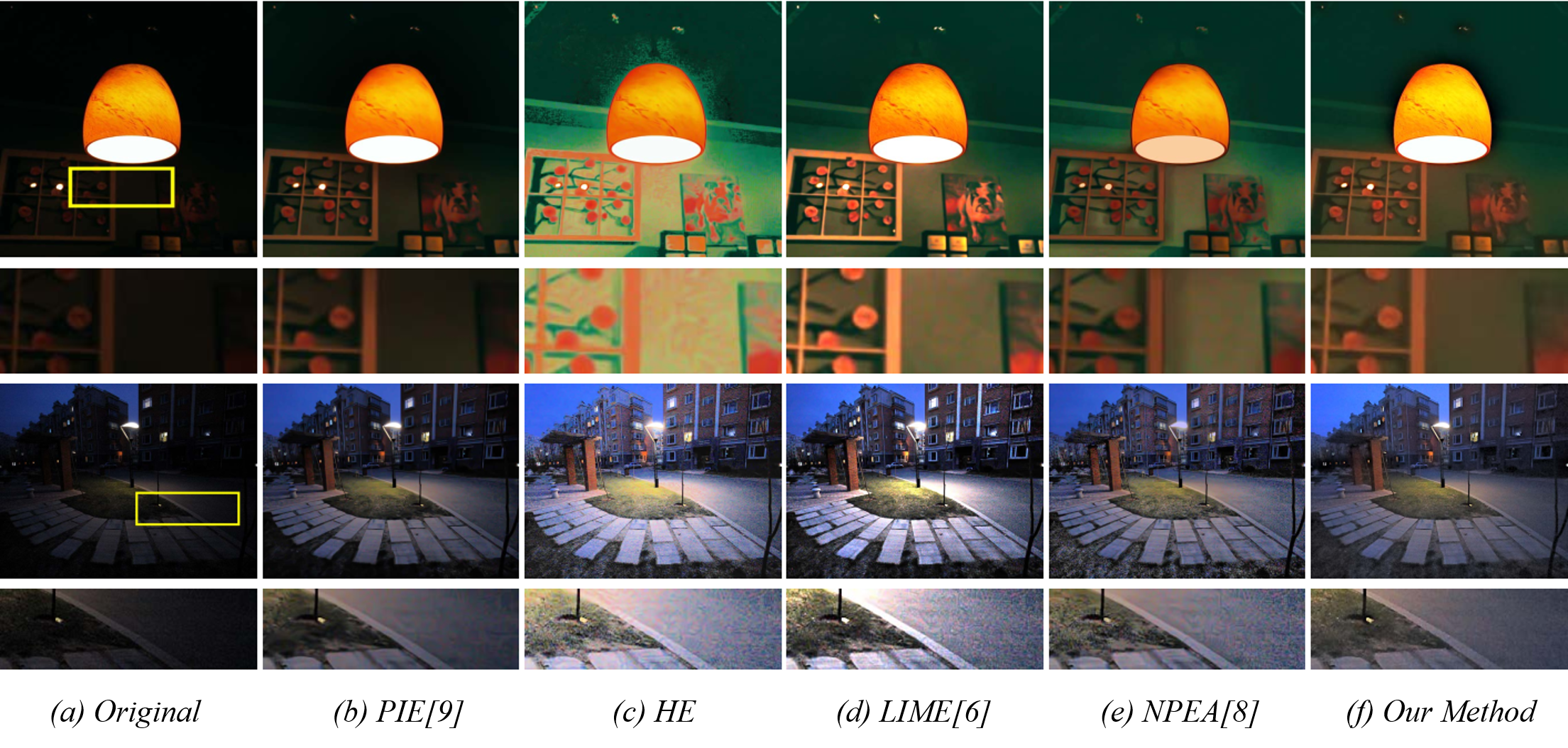Joint Enhancement and Denoising Method
via Sequential Decomposition
Abstract
Many low-light enhancement methods ignore intensive noise in original images. As a result, they often simultaneously enhance the noise as well. Furthermore, extra denoising procedures adopted by most methods may ruin the details. In this paper, we introduce a joint low-light enhancement and denoising strategy, aimed at obtaining great enhanced low-light images while getting rid of the inherent noise issue simultaneously. The proposed method performs Retinex model based decomposition in a successive sequence, which sequentially estimates a piece-wise smoothed illumination and an noise-suppressed reflectance. After getting the illumination and reflectance map, we adjust the illumination layer and generate our enhancement result. In this noise-suppressed sequential decomposition process we enforce the spatial smoothness on each component and skillfully make use of weight matrices to suppress the noise and improve the contrast. Results of extensive experiments demonstrate the effectiveness and practicability of our method. It performs well for a wide variety of images, and achieves better or comparable quality compared with the state-of-the-art methods.
Framework

Fig.1 Framework of the proposed method. We first use an initial illumination to refine the final illumination. Following that we use the obtained illumination map and gradient matrices W and G to amplify the reflectance in RGB space. Then the enhanced image is generated from the illumination and reflectance.
Experimental Results
All experiments are performed on MATLAB R2017a with 4G RAM and Intel Core i5-4210H CPU @2.90GHz.

Fig.2 Comparisons of low-light image enhancement results.

Fig.3 Comparisons of noisy low-light image enhancement results, all methods except ours are followed by BM3D[4].
More Results
Qualitative Evaluation




Fig.4 More results of our work. In the first line of each block are the input low-light and noisy images. The second line are our results. The left of the last two images is the input image and the right one is our result.
Quantitative Evaluation
The following table shows the quantitative comparisons between our method and other existing methods. BSDA500 dataset is used to generate our simulated images. We dim those images with Gamma transfer first and after that add Gaussian noise with variance of 20 to generate Dataset 1. Dataset 2 is generated by adding Gaussian noise first and then dimming the images. The results displayed below are calculated on both datasets.
| Metric\Method | LIME[6] | SRIE[5] | PIE[9] | HE | NPEA[8] | Our Method |
| PSNR | 17.3433 | 17.3694 | 18.3194 | 18.3456 | 17.7078 | 21.6287 |
|---|---|---|---|---|---|---|
| SSIM | 0.59437 | 0.64803 | 0.66433 | 0.59891 | 0.64727 | 0.81661 |
Table.1 Comparisons of PSNR and SSIM results.
Reference
[1] S. M. Pizer, R. E. Johnston, J. P. Ericksen, B. C. Yankaskas, and K. E. Muller, "Contrast-limited adaptive histogram equalization: speed and effectiveness," in [1990] Proceedings of the First Conference on Visualization in Biomedical Computing, May 1990, pp. 337-345.
[2] L. Li, R. Wang, W. Wang, and W. Gao, "A low-light image enhancement method for both denoising and contrast enlarging," in 2015 IEEE International Conference on Image Processing (ICIP), Sept 2015, pp. 3730-3734.
[3] L. Zhang, P. Shen, X. Peng, G. Zhu, J. Song, W. Wei, and H. Song, "Simultaneous enhancement and noise reduction of a single low-light image," IET Image Processing, vol. 10, no. 11, pp. 840-847, 2016.
[4] K. Dabov, A. Foi, V. Katkovnik, and K. Egiazarian, "Image denoising by sparse 3-D transform-domain collaborative filtering," IEEE Transactions on Image Processing, vol. 16, no. 8, pp. 2080-2095, Aug 2007.
[5] X. Fu, D. Zeng, Y. Huang, X. P. Zhang, and X. Ding, "A weighted variational model for simultaneous reflectance and illumination estimation," in 2016 IEEE Conference on Computer Vision and Pattern Recognition (CVPR), June 2016, pp. 2782-2790.
[6] X. Guo, Y. Li, and H. Ling, "LIME: Low-light image enhancement via illumination map estimation," IEEE Transactions on Image Processing, vol. 26, no. 2, pp. 982-993, Feb 2017.
[7] H. Yue, J. Yang, X. Sun, F. Wu, and C. Hou, "Contrast enhancement based on intrinsic image decomposition," IEEE Transactions on Image Processing, vol. 26, no. 8, pp. 3981-3994, Aug 2017.
[8] S. Wang, J. Zheng, H. M. Hu, and B. Li, "Naturalness preserved enhancement algorithm for non-uniform illumination images," IEEE Transactions on Image Processing, vol. 22, no. 9, pp. 3538-3548, Sept 2013.
[9] X. Fu, Y. Liao, D. Zeng, Y. Huang, X. P. Zhang, and X. Ding, "A probabilistic method for image enhancement with simultaneous illumination and reflectance estimation," IEEE Transactions on Image Processing, vol. 24, no. 12, pp. 4965-4977, Dec 2015.